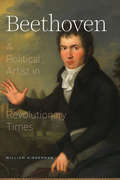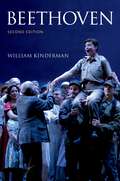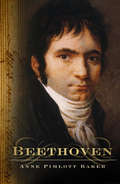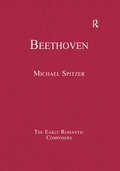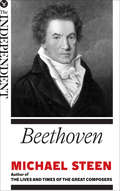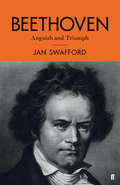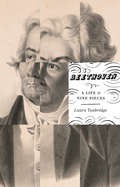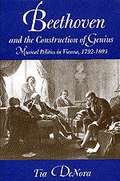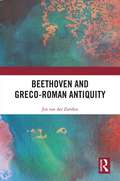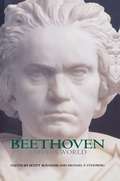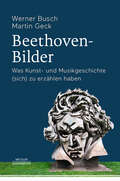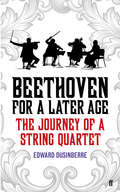- Table View
- List View
Beethoven: The Imperative Of Originality In The Symphony (Eastman Studies In Music Ser. #172)
by Mark Evan BondsDespite the ups and downs of his personal life and professional career-even in the face of deafness-Beethoven remained remarkably consistent in his most basic convictions about his art. This inner consistency, the music historian Mark Evan Bonds argues, provides the key to understanding the composer's life and works. Beethoven approached music as he approached life, weighing whatever occupied him from a variety of perspectives: a melodic idea, a musical genre, a word or phrase, a friend, a lover, a patron, money, politics, religion. His ability to unlock so many possibilities from each helps explain the emotional breadth and richness of his output as a whole, from the heaven-storming Ninth Symphony to the eccentric Eighth, and from the arcane Great Fugue to the crowd-pleasing Wellington's Victory. Beethoven's works, Bonds argues, are a series of variations on his life. The iconic scowl so familiar from later images of the composer is but one of many attitudes he could assume and project through his music. The supposedly characteristic furrowed brow and frown, moreover, came only after his time. Discarding tired myths about the composer, Bonds proposes a new way of listening to Beethoven by hearing his music as an expression of his entire self, not just his scowling self.
Beethoven: A Political Artist in Revolutionary Times (Beethoven Sketchbook Ser.)
by William KindermanWe have long regarded Beethoven as a great composer, but we rarely appreciate that he was also an eminently political artist. This book unveils the role of politics in his oeuvre, elucidating how the inherently political nature of Beethoven’s music explains its power and endurance. William Kinderman presents Beethoven as a civically engaged thinker faced with severe challenges. The composer lived through many tumultuous events—the French Revolution, the rise and fall of Napoleon Bonaparte, and the Congress of Vienna among them. Previous studies of Beethoven have emphasized the importance of his personal suffering and inner struggles; Kinderman instead establishes that musical tensions in works such as the Eroica, the Appassionata, and his final piano sonata in C minor reflect Beethoven’s attitudes toward the political turbulence of the era. Written for the 250th anniversary of his birth, Beethoven takes stock of the composer’s legacy, showing how his idealism and zeal for resistance have ensured that masterpieces such as the Ninth Symphony continue to inspire activists around the globe. Kinderman considers how the Fifth Symphony helped galvanize resistance to fascism, how the Sixth has energized the environmental movement, and how Beethoven’s civic engagement continues to inspire in politically perilous times. Uncertain times call for ardent responses, and, as Kinderman convincingly affirms, Beethoven’s music is more relevant today than ever before.
Beethoven: A Political Artist in Revolutionary Times
by William KindermanWe have long regarded Beethoven as a great composer, but we rarely appreciate that he was also an eminently political artist. This book unveils the role of politics in his oeuvre, elucidating how the inherently political nature of Beethoven’s music explains its power and endurance. William Kinderman presents Beethoven as a civically engaged thinker faced with severe challenges. The composer lived through many tumultuous events—the French Revolution, the rise and fall of Napoleon Bonaparte, and the Congress of Vienna among them. Previous studies of Beethoven have emphasized the importance of his personal suffering and inner struggles; Kinderman instead establishes that musical tensions in works such as the Eroica, the Appassionata, and his final piano sonata in C minor reflect Beethoven’s attitudes toward the political turbulence of the era. Written for the 250th anniversary of his birth, Beethoven takes stock of the composer’s legacy, showing how his idealism and zeal for resistance have ensured that masterpieces such as the Ninth Symphony continue to inspire activists around the globe. Kinderman considers how the Fifth Symphony helped galvanize resistance to fascism, how the Sixth has energized the environmental movement, and how Beethoven’s civic engagement continues to inspire in politically perilous times. Uncertain times call for ardent responses, and, as Kinderman convincingly affirms, Beethoven’s music is more relevant today than ever before.
Beethoven: Evolution, Analysis, Interpretation (Eastman Studies In Music Ser. #172)
by William KindermanCombining musical insight with the most recent research, William Kinderman's Beethoven is both a richly drawn portrait of the man and a guide to his music. Kinderman traces the composer's intellectual and musical development from the early works written in Bonn to the Ninth Symphony and the late quartets, looking at compositions from different and original perspectives that show Beethoven's art as a union of sensuous and rational, of expression and structure. In analyses of individual pieces, Kinderman shows that the deepening of Beethoven's musical thought was a continuous process over decades of his life. In this new updated edition, Kinderman gives more attention to the composer's early chamber music, his songs, his opera Fidelio, and to a number of often-neglected works of the composer's later years and fascinating projects left incomplete. A revised view emerges from this of Beethoven's aesthetics and the musical meaning of his works. Rather than the conventional image of a heroic and tormented figure, Kinderman provides a more complex, more fully rounded account of the composer. Although Beethoven's deafness and his other personal crises are addressed, together with this ever-increasing commitment to his art, so too are the lighter aspects of his personality: his humor, his love of puns, his great delight in juxtaposing the exalted and the commonplace.
Beethoven
by William KindermanCombining musical insight with the most recent research, William Kinderman's Beethoven is both a richly drawn portrait of the man and a guide to his music. Kinderman traces the composer's intellectual and musical development from the early works written in Bonn to the Ninth Symphony and the late quartets, looking at compositions from different and original perspectives that show Beethoven's art as a union of sensuous and rational, of expression and structure. In analyses of individual pieces, Kinderman shows that the deepening of Beethoven's musical thought was a continuous process over decades of his life. In this new updated edition, Kinderman gives more attention to the composer's early chamber music, his songs, his opera Fidelio, and to a number of often-neglected works of the composer's later years and fascinating projects left incomplete. A revised view emerges from this of Beethoven's aesthetics and the musical meaning of his works. Rather than the conventional image of a heroic and tormented figure, Kinderman provides a more complex, more fully rounded account of the composer. Although Beethoven's deafness and his other personal crises are addressed, together with this ever-increasing commitment to his art, so too are the lighter aspects of his personality: his humor, his love of puns, his great delight in juxtaposing the exalted and the commonplace.
Beethoven: Simplified Characters
by Anne Pimlott BakerConsidered by many the world's greatest composer, Ludwig van Beethoven achieved his ambitions against the difficulties of a bullying and drunken father, growing deafness and mounting ill-health. This biography tells the story of his life and work from his birth in Bonn in 1770 and his early employment as a court musician to his death in Vienna in 1827. It describes his studies with Haydn in Vienna and his work during the French Revolution and the rise of Napoleon. His most financially successful period followed the Congress of Vienna in 1815, despite several unhappy love affairs and continuous worry over his nephew, Karl.
Beethoven
by Michael SpitzerOur image of Beethoven has been transformed by the research generated by a succession of scholars and theorists who blazed new trails from the 1960s onwards. This collection of articles written by leading Beethoven scholars brings together strands of this mainly Anglo-American research over the last fifty years and addresses a range of key issues. The volume places Beethoven scholarship within a historical and contemporary context and considers the future of Beethoven studies.
Beethoven: Adorno And Beethoven's Late Style (The\early Romantic Composers Ser.)
by Michael SpitzerOur image of Beethoven has been transformed by the research generated by a succession of scholars and theorists who blazed new trails from the 1960s onwards. This collection of articles written by leading Beethoven scholars brings together strands of this mainly Anglo-American research over the last fifty years and addresses a range of key issues. The volume places Beethoven scholarship within a historical and contemporary context and considers the future of Beethoven studies.
Beethoven: The Great Composers (The Great Composers)
by Michael SteenWelcome to The Independent’s new ebook series The Great Composers, covering fourteen of the giants of Western classical music. Extracted from Michael Steen’s book The Lives and Times of the Great Composers, these concise guides, selected by The Independent’s editorial team, explore the lives of composers as diverse as Mozart and Puccini, reaching from Bach to Brahms, set against the social, historical and political forces which affected them, to give a rounded portrait of what it was like to be alive and working as a musician at that time. In this ebook Steen traces Beethoven's tumultuous life, buffeted by the violent cross-currents of the French Revolution and the Napoleonic wars which convulsed Europe from the end of the 18th century to the beginning of the 19th. Born in Bonn, Beethoven became a successful musician patronised by the aristocracy. Though scornful of social convention, he conquered Vienna, creating works which rewrote the rulebook for all the musical forms he touched. Irascible and argumentative, Beethoven was a troubled genius; frustrated by politics, exasperated by friends, foes, and family, and plagued by the gradual loss of his hearing which began when he was still in his 20s. While conflicts raged about him and within him, he constantly surprised people by doing the unexpected and staying fiercely independent. He was among the first to bring the piano to the fore rather than the harpsichord, as the larger sound could play along with the rest of the orchestra in a hall. Beethoven could always turn to his love of music even when ill-health led him to consider suicide, the wars devalued his earnings, and the love for his nephew Karl and the infamous ‘Immortal Beloved’ was never returned. Today he remains one of the world's best-loved composers.
Beethoven: Anguish and Triumph
by Jan SwaffordSunday Times Classical Music Book of the Year'Magisterial, warm, and engaging . . . A triumph of scholarship and musical affinity . . . Jan Swafford is to be saluted.' IndependentJan Swafford's biographies of composers Charles Ives and Johannes Brahms have established him as a revered music historian, capable of bringing his subjects vibrantly to life. His magnificent new biography of Ludwig van Beethoven peels away layers of legend to get to the living, breathing human being who composed some of the world's most iconic music. Swafford mines sources never before used in English-language biographies to reanimate the revolutionary ferment of Enlightenment-era Bonn, where Beethoven grew up and imbibed the ideas that would shape all of his future work. Swafford then tracks his subject to Vienna, capital of European music, where Beethoven built his career in the face of critical incomprehension, crippling ill health, romantic rejection, and 'fate's hammer', his ever-encroaching deafness. At the time of his death he was so widely celebrated that over ten thousand people attended his funeral.This book is a biography of Beethoven the man and musician, not the myth, and throughout, Swafford - himself a composer - offers insightful readings of Beethoven's key works. More than a decade in the making, this will be the standard Beethoven biography for years to come.
Beethoven: A Life in Nine Pieces
by Laura TunbridgeA major new biography published for the 250th anniversary of Beethoven’s birth, offering a fresh, human portrayal The iconic image of Beethoven is of him as a lone genius: hair wild, fists clenched, and brow furrowed. Beethoven may well have shaped the music of the future, but he was also a product of his time, influenced by the people, politics, and culture around him. Oxford scholar Laura Tunbridge offers an alternative history of Beethoven’s career, placing his music in contexts that shed light on why particular pieces are valued more than others, and what this tells us about his larger-than-life reputation. Each chapter focuses on a period of his life, a piece of music, and a revealing theme, from family to friends, from heroism to liberty. We discover, along the way, Beethoven’s unusual marketing strategies, his ambitious concert programming, and how specific performers and instruments influenced his works. This book offers new ways to understand Beethoven and why his music continues to be valued today.
Beethoven: A Life in Nine Pieces
by Laura Tunbridge2020 marks 250 years since Beethoven's birthLudwig van Beethoven: to some, simply the greatest ever composer of Western classical music. Yet his life remains shrouded in myths, and the image persists of him as an eccentric genius shaking his fist at heaven.Beethoven by Oxford professor Laura Tunbridge cuts through the noise in a refreshing way. Each chapter focuses on a period of his life, a piece of music and a revealing theme, from family to friends, from heroism to liberty. It's a winning combination of rich biographical detail, insight into the music and surprising new angles, all of which can transform how you listen to his works. We discover, for example, Beethoven's oddly modern talent for self-promotion, how he was influenced by factors from European wars to instrument building, and how he was heard by contemporaries.This tour de force - published for the 250th anniversary of Beethoven's birth - provides a fresh overview and a wealth of material that has never been revealed to the wider public before. It's a compelling, human portrayal of Beethoven and a fascinating journey into one of the world's most amazing creative minds.'We are doubly blessed that Beethoven should have led such an extraordinary life. Laura has combined the two - the genius of his music and the richness of his experiences - to shine a revealing light on our greatest composer' John Humphrys'Tunbridge has come up with the seemingly impossible: a new way of approaching Beethoven's life and music. . . profoundly original and hugely readable' John Suchet, author Beethoven: The Man Revealed'This well researched and accessible book is a must read for all who seek to know more about the flesh and blood tangible Beethoven.'John Clubbe, author of Beethoven: The Relentless Revolutionary'This book is really wonderful! ... However many books on Beethoven you own, find the space for one more. This one'Stephen Hough, pianist, composer, writer'In a year when everyone's looking for a new take on Beethoven, Laura Tunbridge has found nine. ...Fresh and engaging'Norman Lebrecht, author of Genius and Anxiety'Remarkable . . . she captures the essence of his genius and character. I'll always want to keep it in easy reach'Julia Boyd, author of Travellers in the third Reich
Beethoven 1806 (AMS Studies in Music)
by Mark FerragutoBetween early 1806 and early 1807, Ludwig van Beethoven completed a remarkable series of instrumental works. But critics have struggled to reconcile the music of this banner year with Beethoven's "heroic style," the paradigm through which his middle-period works have typically been understood. Drawing on theories of mediation and a wealth of primary sources, Beethoven 1806 explores the specific contexts in which the music of this year was conceived, composed, and heard. As author Mark Ferraguto argues, understanding this music depends on appreciating the relationships that it both creates and reflects. Not only did Beethoven depend on patrons, performers, publishers, critics, and audiences to earn a living, but he also tailored his compositions to suit particular sensibilities, proclivities, and technologies.
Beethoven 1806 (AMS Studies in Music)
by Mark FerragutoBetween early 1806 and early 1807, Ludwig van Beethoven completed a remarkable series of instrumental works. But critics have struggled to reconcile the music of this banner year with Beethoven's "heroic style," the paradigm through which his middle-period works have typically been understood. Drawing on theories of mediation and a wealth of primary sources, Beethoven 1806 explores the specific contexts in which the music of this year was conceived, composed, and heard. As author Mark Ferraguto argues, understanding this music depends on appreciating the relationships that it both creates and reflects. Not only did Beethoven depend on patrons, performers, publishers, critics, and audiences to earn a living, but he also tailored his compositions to suit particular sensibilities, proclivities, and technologies.
BEETHOVEN 32 PIANO SONATAS C: A Handbook for Performers
by Stewart GordonThe thirty-two Piano Sonatas of Ludwig van Beethoven form one of the most important segments of piano literature. In this accessible, compact, and comprehensive guidebook, renowned performer and pedagogue Stewart Gordon presents the pianist with historical insights and practical instructional tools for interpreting the pieces. In the opening chapters of Beethoven's 32 Piano Sonatas, Gordon illuminates the essential historical context behind common performance problems, discussing Beethoven's own pianos and how they relate to compositional style and demands in the pieces, and addressing textual issues, performance practices, and nuances of the composer's manuscript inscriptions. In outlining patterns of structure, sonority, keyboard technique, and emotional meaning evident across Beethoven's compositional development, Gordon provides important background and technical information key to understanding his works in context. Part II of the book presents each sonata in an outline-chart format, giving the student and teacher ready access to essential information, interpretive choices, and technical challenges in the individual works, measure by measure, all in one handy reference source. In consideration of the broad diversity of today's Beethoven interpreters, Gordon avoids one-size-fits-all solutions or giving undue weight to his own tastes and preferences. Instead, he puts the choices in the hands of the performers, enabling them to create their own personal relationship with the music and a more powerful performance.
Beethoven And The Construction Of Genius: Musical Politics In Vienna, 1792-1803 (PDF)
by Tia DeNoraIn this provocative account Tia DeNora reconceptualizes the notion of genius by placing the life and career of Ludwig van Beethoven in its social context. She explores the changing musical world of late eighteenth-century Vienna and follows the activities of the small circle of aristocratic patrons who paved the way for the composer's success. DeNora reconstructs the development of Beethoven's reputation as she recreates Vienna's robust musical scene through contemporary accounts, letters, magazines, and myths-a colorful picture of changing times. She explores the ways Beethoven was seen by his contemporaries and the image crafted by his supporters. Comparing Beethoven to contemporary rivals now largely forgotten, DeNora reveals a figure musically innovative and complex, as well as a keen self-promoter who adroitly managed his own celebrity. DeNora contends that the recognition Beethoven received was as much a social achievement as it was the result of his personal gifts. In contemplating the political and social implications of culture, DeNora casts many aspects of Beethoven's biography in a new and different light, enriching our understanding of his success as a performer and composer.
Beethoven and Greco-Roman Antiquity
by Jos van ZandenLudwig van Beethoven had a life beyond music. He considered it his duty to spend leisure-time improving his Bildung (sophistication). To this end he familiarised himself with tangible manifestations of Greco-Roman antiquity, for he perceived these cultures and their representatives as examples of intellectual, moral, and artistic perfection. He consumed such writers as Homer, Plutarch, Horace, Tacitus, Euripides, and Greek poets. These texts were morally uplifting for him, and advantageous for building character. They now hold a key to Beethoven’s ideal of a steadfast, austere, and Stoic outlook, necessary for a ‘great man’ to carry out his duties. Jos van der Zanden demonstrates that Beethoven’s engagement with Greco-Roman culture was deep and ongoing, and that it ventured beyond the non-committal. Drawing on a comprehensive investigation of primary sources (letters, conversation books, diaries, recollections of contemporaries) he examines what Beethoven knew of such topics like history, art, politics, and philosophy of antiquity. The book presents new information on the composer’s republicanism, his familiarity with the works of Plato, his admiration of the elderly Brutus, his plan to utilize ‘unresolved dissonances’ in an unknown piece of music, and his decision to subscribe to a book about ancient Greek poetry. A hitherto unknown vocal piece based on lines by Euripides is revealed. The study concludes with a comprehensive survey of all compositions and sketches by Beethoven based on Greco-Roman subjects.
Beethoven and Greco-Roman Antiquity
by Jos van ZandenLudwig van Beethoven had a life beyond music. He considered it his duty to spend leisure-time improving his Bildung (sophistication). To this end he familiarised himself with tangible manifestations of Greco-Roman antiquity, for he perceived these cultures and their representatives as examples of intellectual, moral, and artistic perfection. He consumed such writers as Homer, Plutarch, Horace, Tacitus, Euripides, and Greek poets. These texts were morally uplifting for him, and advantageous for building character. They now hold a key to Beethoven’s ideal of a steadfast, austere, and Stoic outlook, necessary for a ‘great man’ to carry out his duties. Jos van der Zanden demonstrates that Beethoven’s engagement with Greco-Roman culture was deep and ongoing, and that it ventured beyond the non-committal. Drawing on a comprehensive investigation of primary sources (letters, conversation books, diaries, recollections of contemporaries) he examines what Beethoven knew of such topics like history, art, politics, and philosophy of antiquity. The book presents new information on the composer’s republicanism, his familiarity with the works of Plato, his admiration of the elderly Brutus, his plan to utilize ‘unresolved dissonances’ in an unknown piece of music, and his decision to subscribe to a book about ancient Greek poetry. A hitherto unknown vocal piece based on lines by Euripides is revealed. The study concludes with a comprehensive survey of all compositions and sketches by Beethoven based on Greco-Roman subjects.
Beethoven and His World (The Bard Music Festival #48)
by Scott Burnham Michael P. SteinbergFew composers even begin to approach Beethoven's pervasive presence in modern Western culture, from the concert hall to the comic strip. Edited by a cultural historian and a music theorist, Beethoven and His World gathers eminent scholars from several disciplines who collectively speak to the range of Beethoven's importance and of our perennial fascination with him. The contributors address Beethoven's musical works and their cultural contexts. Reinhold Brinkmann explores the post-revolutionary context of Beethoven's "Eroica" Symphony, while Lewis Lockwood establishes a typology of heroism in works like Fidelio. Elaine Sisman, Nicholas Marston, and Glenn Stanley discuss issues of temporality, memory, and voice in works at the threshold of Beethoven's late style, such as An die Ferne Geliebte, the Cello Sonata op. 102, no. 1, and the somewhat later Piano Sonata op. 109. Peering behind the scenes into Beethoven's workshop, Tilman Skowroneck explains how the young Beethoven chose his pianos, and William Kinderman shows Beethoven in the process of sketching and revising his compositions. The volume concludes with four essays engaging the broader question of reception of Beethoven's impact on his world and ours. Christopher Gibbs' study of Beethoven's funeral and its aftermath features documentary material appearing in English for the first time; art historian Alessandra Comini offers an illustrated discussion of Beethoven's ubiquitous and iconic frown; Sanna Pederson takes up the theme of masculinity in critical representations of Beethoven; and Leon Botstein examines the aesthetics and politics of hearing extramusical narratives and plots in Beethoven's music. Bringing together varied and fresh approaches to the West's most celebrated composer, this collection of essays provides music lovers with an enriched understanding of Beethoven--as man, musician, and phenomenon.
Beethoven-Bilder: Was Kunst- und Musikgeschichte (sich) zu erzählen haben
by Werner Busch Martin GeckBeethoven-Bildnisse gibt es seit über 200 Jahren, und jenseits des omnipräsenten Titanenhauptes gibt es eine Vielfalt von Gestaltungen in gezeichneter, gemalter und plastischer Form, die viel über ihre jeweilige Zeit und über unsere Zugänge zu Beethovens Musik zu erkennen geben. Eine originelle Perspektive auf 200 Jahre Kulturgeschichte eröffnet dieses Gespräch zwischen einem Musik- und einem Kunsthistoriker beim Betrachten diverser Beethoven-Bilder und -Denkmäler. Das reicht vom Klassizismus der Goethezeit bis zum Dekonstruktivismus der Gegenwart, von Joseph Stieler bis Markus Lüpertz, von Napoleon Bonaparte bis Wilhelm Furtwängler und Mauricio Kagel. Ein unterhaltsames und erhellendes Gespräch zweier ausgewiesener Vertreter ihres Fachs.
Beethoven for a Later Age: The Journey of a String Quartet
by Edward Dusinberre'They are not for you but for a later age!' Ludwig van Beethoven, on the Opus 59 quartets.Tackling the Beethoven quartets is a rite of passage that has shaped the Takács Quartet's work together for over forty years. Using the history of the composition and first performances of the quartets as the backbone to his story, Edward Dusinberre, first violinist of the Takács since 1993 - recounts the life of the Quartet from its inception in Hungary, through emigration to the US and its present-day life as one of the world's renowned string quartets. He also describes what it was like for him, as a young man fresh out of the Juilliard School, to join the Quartet as its first non-Hungarian member - an exhilarating challenge. Beethoven for a Later Age takes the reader inside the life of a quartet, vividly showing how four people enjoy making music together over a long period of time. The key, the author argues, is in balancing continuity with change and experimentation - a theme that also lies at the heart of Beethoven's remarkable compositions.
Beethoven for a Later Age: Living with the String Quartets
by Edward DusinberreBeethoven’s sixteen string quartets are some of the most extraordinary and challenging pieces of music ever written. Originally composed and performed between 1798 and 1826, they have inspired artists of all kinds—not only musicians—and have been subject to endless reinterpretation. But what is it like to personally take up the challenge of these compositions, not only as a musician, but as a member of a quartet, where each player has ideas about style and expression? To answer this question, Edward Dusinberre, first violinist of the renowned Takács Quartet, offers a rare peek inside the workings of his ensemble, while providing an insightful history of the compositions and their performance. Founded in Hungary in 1975 and now based in Boulder, Colorado, the Takács is one of the world’s preeminent string quartets, and performances of Beethoven have been at the center of their work together for over forty years. Using the history of both the Takács Quartet and the Beethoven quartets as a foundation, Beethoven for a Later Age provides a backstage look at the daily life of a quartet, showing the necessary creative tension between individual and group and how four people can at the same time forge a lasting artistic connection and enjoy making music together over decades. The key, Dusinberre reveals, to a quartet crafting its own sound is in balancing continuity with change and experimentation—a theme that lies at the heart of Beethoven’s remarkable compositions. In an accessible style, suitable for novices and chamber music enthusiasts alike, Dusinberre illuminates the variety and contradictions of Beethoven's quartets, which were composed against the turbulent backdrop of the Napoleonic Wars and their aftermath, and he brings the technical aspects of the music to life. Beethoven for a Later Age vividly shows that creative engagement with Beethoven’s radical and brilliant quartets continues to be as stimulating now as it was for its first performers and audiences. Musicians and music lovers will be intrigued by Dusinberre’s exploration of the close collaboration at the heart of any great performance.
Beethoven for a Later Age: Living with the String Quartets
by Edward DusinberreBeethoven’s sixteen string quartets are some of the most extraordinary and challenging pieces of music ever written. Originally composed and performed between 1798 and 1826, they have inspired artists of all kinds—not only musicians—and have been subject to endless reinterpretation. But what is it like to personally take up the challenge of these compositions, not only as a musician, but as a member of a quartet, where each player has ideas about style and expression? To answer this question, Edward Dusinberre, first violinist of the renowned Takács Quartet, offers a rare peek inside the workings of his ensemble, while providing an insightful history of the compositions and their performance. Founded in Hungary in 1975 and now based in Boulder, Colorado, the Takács is one of the world’s preeminent string quartets, and performances of Beethoven have been at the center of their work together for over forty years. Using the history of both the Takács Quartet and the Beethoven quartets as a foundation, Beethoven for a Later Age provides a backstage look at the daily life of a quartet, showing the necessary creative tension between individual and group and how four people can at the same time forge a lasting artistic connection and enjoy making music together over decades. The key, Dusinberre reveals, to a quartet crafting its own sound is in balancing continuity with change and experimentation—a theme that lies at the heart of Beethoven’s remarkable compositions. In an accessible style, suitable for novices and chamber music enthusiasts alike, Dusinberre illuminates the variety and contradictions of Beethoven's quartets, which were composed against the turbulent backdrop of the Napoleonic Wars and their aftermath, and he brings the technical aspects of the music to life. Beethoven for a Later Age vividly shows that creative engagement with Beethoven’s radical and brilliant quartets continues to be as stimulating now as it was for its first performers and audiences. Musicians and music lovers will be intrigued by Dusinberre’s exploration of the close collaboration at the heart of any great performance.


